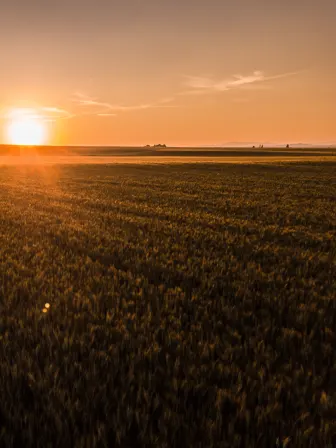Planning for Climate Change
Source
About This Document
Whether they take credit for it or not, land trusts already plan for climate change. This document outlines tools and approaches land trusts can use to plan for climate change in the short-term and long-term.
© 2022 Land Trust Alliance, Inc. All rights reserved.
Whether they take credit for it or not, land trusts already plan for climate change. In the Northeast, they monitor forests to see if warming temperatures will drive species such as the sugar maple (along with local maple syrup for their pancakes) toward more northern climes. Along the Gulf Coast, they restore marshes that stand as a bulwark against rising sea levels, and the storm surges of climate-fueled hurricanes. In the West, land trusts endure the “heat dome” effect as they manage forest fire threats across a fire season that once lasted several weeks, but may now linger until the first snow.
Such efforts to reduce the impact of climate change are generally known as adaptation. Land trusts adapt when they thin trees in a fire-prone forest ravaged by pine beetles that thrive in milder winters. In urban settings, they adapt by building parking lot bioswales thick with native plants that filter and absorb increased levels of stormwater runoff. Taken together, these measures can reduce risks to people, places and resources.
Climate adaptation will become a standard practice for land trusts in the decades ahead. And, the lands and wild creatures that they steward in perpetuity will be the better for it. That said, what adaptation cannot do is stop climate change in the short-term. We might compare the current state of the earth’s overheated atmosphere to an urban downtown after a hot day. At dusk, as the light fades and the neon-lit restaurants beckon, we can still feel the day’s heat as it emanates from the concrete buildings and sidewalks. Similarly, even if we stopped burning fossil fuels tomorrow, the earth’s average temperature will not soon return to pre-Industrial Revolution levels. The excess greenhouse gases that drive climate change, namely carbon dioxide and methane, can take decades to dissipate.
Meanwhile, as global temperatures rise, they will interact with nearly all aspects of our climate. They will affect the amount and timing of precipitation, along with wind intensity and the frequency and severity of storms. A warming climate can also cause famine and drought and make climate refugees of people and animals alike. These effects, known as climate change impacts, are happening faster than in previous periods of climate change. Yet land trusts need not throw in the towel. With the right mix of tools and approaches, they can plan for climate change in the short-term and long-term.
Predicting the unpredictable
Whether a plan covers six years or 60, its underlying purpose remains the same: to help manage uncertainty. It’s not that anyone can prevent uncertainty; we expect oceans to rise, glaciers to melt, rivers to flood (or run dry) in response to a warming world. Land trusts, however, can improve their readiness to manage such problems. For instance, we may not know which new invasive species will show up next. But before the next quagga mussel or spotted lanternfly appears, we can devise an action plan that considers the impact — environmental, economic and social — of such an outbreak.
Essentially, these and other plans seek to build resilience in the lands they protect. Resilience is the x factor upon which all sound conservation depends. Just as a healthy body can better fight off disease, so can a resilient landscape use its natural processes to better endure climate extremes. Resilient habitats are complex and nutrient-dense; they are rich in reciprocal relationships from the microbe to the mega-fauna level. This vitality allows them to rebound from fires, floods and droughts with their key biologic functions still intact.
Lending biodiversity a hand
Given their multi-layered nature, resilient landscapes tend to harbor and foster biodiversity. As climate change drives shifts in species and ecosystems, conservation plans based on current biodiversity patterns will become less effective at sustaining species and natural processes over the long term. The Nature Conservancy’s scientists are working to addresses this problem by identifying and mapping a Resilient and Connected Network of sites across the continental US that collectively represent the natural diversity of the country. These resilient sites have unique topographies, geologies, and other characteristics that can help withstand climate impacts and keep nature safe in the face of climate change.
Creating connectivity, building green infrastructure
In wilderness areas, large swaths of land create mosaics of rivers and wetlands, prairies and forests, coastal marshes and seashore. Elsewhere, natural areas often exist as isolated islands -- as anyone whose looked out an airplane window during a cross-country flight can attest. The trouble is, dynamic ecosystems weren’t designed to thrive within the square confines of a surveyed parcel. Wildlife need safe routes for movement that connect by land and water to other natural areas. To link isolated habitats, land trusts can create buffer zones and corridors; even wildlife bridges over busy highways. These “exit ramps” allow animals to migrate, pursue food sources and escape climate-driven threats such as new predators or competitors.
For land trusts, such integrated projects are rarely a solo venture. To build connectivity land trusts must themselves connect with others landowners, agencies and communities. And, as organizations immersed in their communities, land are well-suited to help stitch together disparate properties into a unified whole.
In places where urban and natural areas intersect, green infrastructure projects can provide a conduit for connectivity. Green infrastructure harnesses the cleansing powers of nature, but with a human twist. For instance, when is a parking lot not just a parking lot? When it includes design features such as permeable asphalt, stormwater swales and buffer strips to absorb street runoff in ways that asphalt parking lots do not. Further, these oases of green soften the hard grey edges of the built environment. Along with aesthetic appeal, tree-lined streets reduce air conditioning costs, while greenbelts and bike paths link parks and preserves like jewels in a terrestrial necklace.
Plan to manage, plan to adapt
For a workable response to climate change, land trusts need sound plans; plans that are visionary enough to imagine a future still decades away, yet practical enough to use next week at a 20-acre preserve down the street. Two common types of plans that fit that bill are adaptive management and scenario planning.
Scenario planning seeks to maintain resilience under a variety of potential future conditions. To get started, the Alliance recommends using the The Nature Conservancy's Resilient Land Mapping Tool and Open Space Institute's Conserving Nature in a Changing Climate. At some level, land trusts already use a form of scenario planning when they decide which land to protect. They look at factors such as:
Planned development (new subdivisions, zoning changes)
Planned road expansion
Status of invasive species population
Condition of surrounding land
With scenario planning, you develop a story of sorts about what would happen if your best-guess projections came to be. Such as, “Will this remnant prairie or woods be surrounded by a new subdivision of freeway interchange?” Or, “If this oak forest falls prey to our growing spongy moth problem how will that effect its value?” While an imperfect science, this fact-finding and forecasting process can lead to better-informed decisions about which lands to protect.
With adaptive management, land trusts can take a more hands-on approach to building resilience as conditions evolve. In form, this resembles the continuous improvement process used by the private sector, with feedback loops to make adjustments in real time. The general steps of adaptive management are:
Assessing conditions; identifying issues; setting goals
Designing an adaptation plan to meet these goals.
Implementing the management plan
Monitoring the impact, evaluating the results
Revising the plan in response to data and changing conditions.
Land trusts can also build adaptive management into the language used to craft conservation easements. Easements have long allowed permitted activities such as sustainable logging, hunting, farming and spaces for new buildings. Given the vagaries of climate change, adaptive easements can allow for both narrow restrictions (i.e. no clear-cutting) and for flexibility (i.e. the need to build fire lanes as dryer summers heighten fire risks).
As with all easements, clarity and understanding between the land trust and landowner are paramount. Avoid any ambiguity that will cause problems after the property changes hands – or, after land trust staff have left the organization. Come what may, climate change or not, easements must stand the test of perpetuity.
These case studies and resources can help provide useful examples and data:
Wildlife and Wildlands Toolkit
Regional Impacts of Climate Change
Sample strategic conservation plans and case studies
Explore related resources

Climate Change Basics
This document reviews the basics of climate change, including impacts of climate change and the future impacts of climate change.
How Your Nonprofit Can Meet the Risks of Climate Change
Climate change will shape the logistics of your organization’s programs for the long term and the types of services your community needs. Learn what risks nonprofits must anticipate due to climate change and how to prepare.

Climate Change Education Partnership Program
The Climate Change Education Partnership supports climate change communication tools and resources across the country.
Local Strategies for Climate change, Vol. 2
Local Strategies for Climate change Volume 2 presents additional information on how communities can plan for and adapt to climate change through stories describing resources that some communities are using to address this pressing management challenge.

Communicating about climate change
Land trusts can use this online guide to help create a climate change communication strategy as your organization’s human and financial resources allow.
Integrating Climate Adaptation into Land Conservation: A Climate-Smart Framework for Land Trusts
This report aims to provide land trusts and other land conservation practitioners with a guide to integrating climate change projections and climate adaptation approaches into the process of private land conservation.
Being Prepared for Climate Change: A Workbook for Developing Risk-Based Adaptation Plans
The Being Prepared for Climate Change workbook guides users to develop a risk-based climate change adaptation plan consisting of a vulnerability assessment and an action plan to reduce the most pressing risks.
USFWS Climate Change Website
The U.S. Fish and Wildlife Service Climate Change website emphasizes adaptation, mitigation and engagement to address impacts to wildlife and natural habitat. This includes Rising to the Urgent Challenge: Strategic Plan for Responding to Accelerating Climate Change.
Climate Change Resource Center
The United States Forest Service's Climate Change Resource Center is a collection of forest management resources. It includes an extensive library, climate change and carbon tools, webinars and short courses by topic area and ecosystem, as well as an introductory webinar for new users.
Conservation Easement Stewardship and Climate Change Policy
This is a sample conservation easement stewardship and climate change policy from the accredited Land Trust of Napa County.